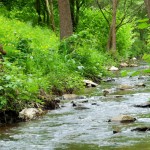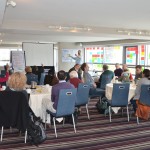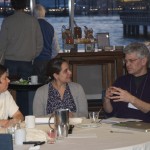In our last issue, Normandale Community College’s Mathematics for the Liberal Arts was identified as a course that aims to inspire students to appreciate the mathematics that surrounds them, the mathematics that is hidden in plain sight. According to Normandale Professor Anthony Dunlop, the ultimate goal he envisioned while designing the course was “to have students think of math whenever they are near Minnesota’s many waterways, and to have at least an inkling that mathematics and quantitative reasoning [are] vital to understanding and protecting these resources.”
The analysis of real data from the nearby Nine Mile Creek Watershed District serves as the instructional framework for Dunlop’s course. Although he has used this framework the three previous times he’s taught Mathematics for the Liberal Arts, he is eager to expand the course into new areas, and expressed excitement that participating in NCSCE’s Engaging Mathematics initiative, which encourages professors to apply the SENCER Ideals to their curricula, will afford him this opportunity. One way he plans to expand the course is by developing new modules. These modules will cover topics such as wildlife management, energy production and use, and water table depletion and replenishment. In keeping with the “math you can see” theme on which his course largely operates, new energy modules will be based on data from a coal-burning plant visible from the Normandale campus. Dunlop states that this “math you can see” way of teaching helps students realize that math is more than “pointless symbol pushing.” After taking his course, students “might still dislike mathematics,” Dunlop says, “but they can no longer claim it’s remote and abstract.”
Dunlop also plans to bundle his course materials into a portable curriculum, so that anyone, at any institution, might teach Mathematics for the Liberal Arts. When asked how he plans to make his course transferable to institutions where the Nine Mile Creek Watershed and coal-burning plant are not “visible,” Dunlop replied that, while he still needs to do further planning in this area, one possibility is to offer the course’s questions and activities as templates, allowing instructors to fill in spreadsheets with data from their own surroundings, which will help ensure all students get the chance to “see” math.
Professor Victor Padron, another member of the Normandale faculty, will also be developing modules for the Engaging Mathematics project. His work will focus on undergraduate research in the areas of groundwater pollution and climate change. Padron’s modules will be transferable into any standard-sequence calculus course. These courses are taken mostly by STEM majors, who, Dunlop says, “are not necessarily interested in mathematics.” He hopes the SENCER approach of combining civic issues with instruction will pique his students’ interest in the subject.
Padron taught a groundwater pollution module once before, during the Fall 2013 semester, as part of Calculus with Linear Algebra and Differential Equations. The module’s research projects require students to apply various calculus techniques as they track both the flow of groundwater and the fate of its contaminants. Padron aims to further develop this module by inserting new examples and exercises, expanding MATLAB accessibility, and developing additional support for instructors.
When asked how MATLAB models help students engage with visually elusive groundwater, Padron replied:
The fact that we are modeling a complex event that is out of sight as ground water makes it necessary to use mathematical models that the computer brings to life. Typically when dealing with data from real events of groundwater pollution, one cannot obtain analytical solutions to the equations involved. A software like MATLAB allows us not only to obtain numerical approximations to the solutions but also to visualize the results, bringing an unseen phenomenon to the surface.
Padron’s model on climate change, another less-than-tangible topic, currently exists only as an initial sketch, but will also include mathematical models. Understanding Earth’s climate requires an understanding of mathematics, Padron states, adding that, “while controlled physical experiments on climate change are rarely available, mathematical models, computational experiments, and data analysis are the fundamental tools” for studying Earth’s climate system.
The White House also sees value in modeling climate change, as evidenced by the recent launch of a new website—climate.data.gov. The site aims, as the New York Times reports, “at turning scientific data about projected droughts and wildfires and the rise in sea levels into eye-catching digital presentations that can be mapped using simple software apps,” in the hopes that people will more readily engage with the issue after learning from models how climate change could affect them directly. Padron’s models will be conceptual, formulated in terms of mean temperature and thermal energy exchange among latitudes. Although these parameters retain only some fundamental features of the climate system, “they are capable of reproducing relevant complex phenomena with a relatively simple mathematical formulation that is well suited to the undergraduate level of mathematical education,” he explains.
For insight into the direction this module may take, browse the Mathematical Association of America’s November 2013 issue of the College Mathematics Journal, which Padron cites as an important starting reference. To stay abreast of the rest of Dunlop and Padron’s advancements, be sure to follow @MathEngaging on Twitter.
Article originally published by Christine Marie DeCarlo on March 28, 2014.





